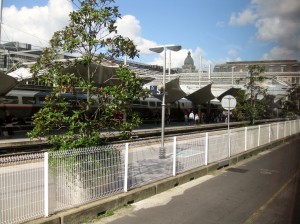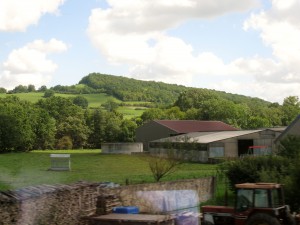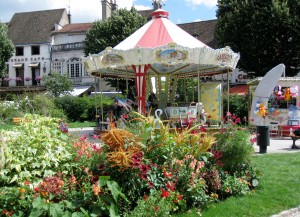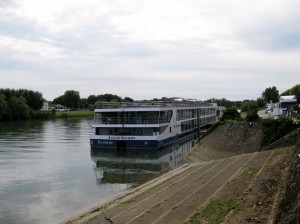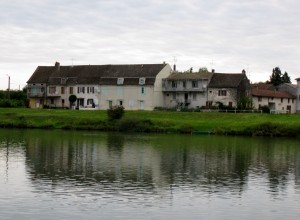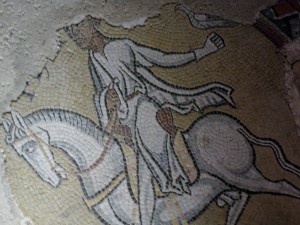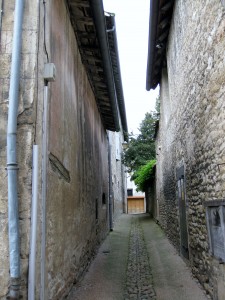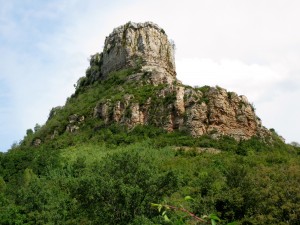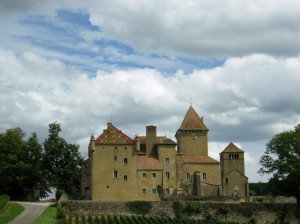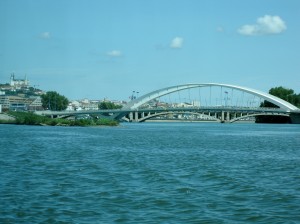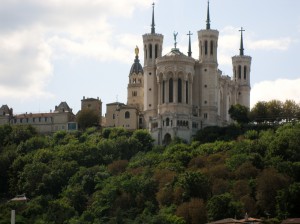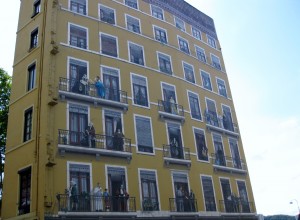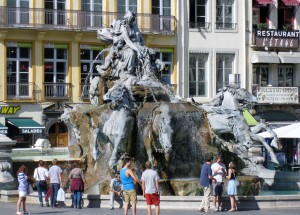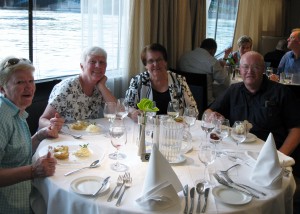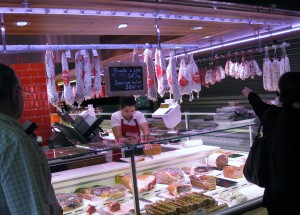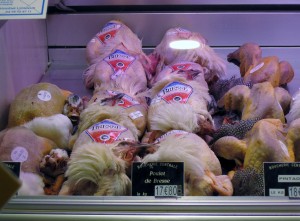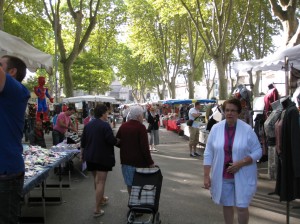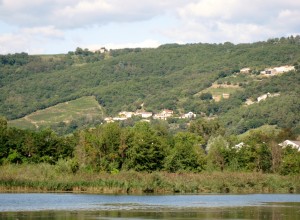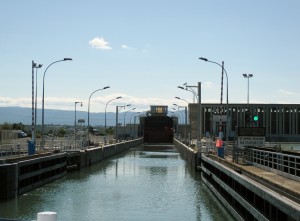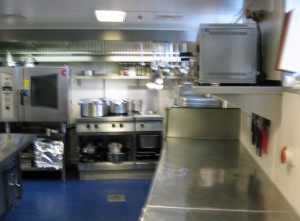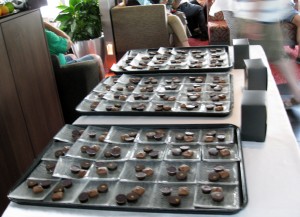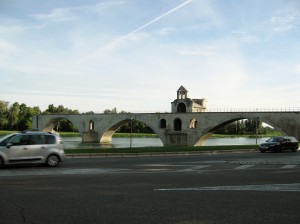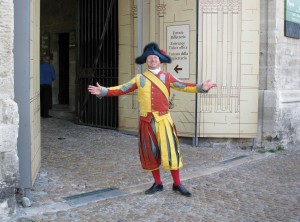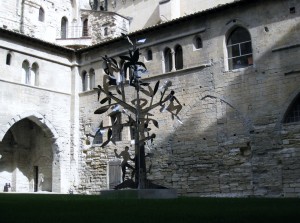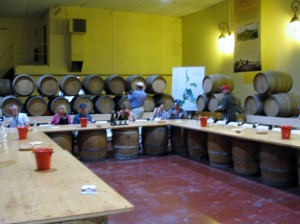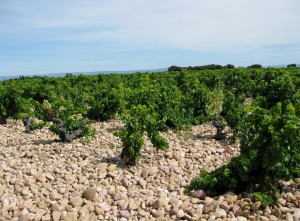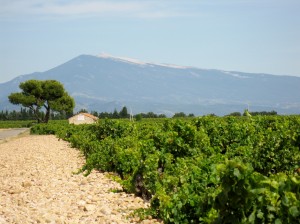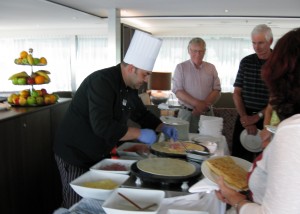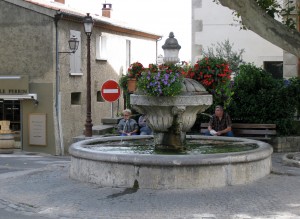August 19: We checked out of the Pullman and waited with our fellow passengers for buses to pick us up. The buses took us to the train station where we boarded the TGV train to Dijon; the train traveled about 183 mph and we got to our destination by riding through the beautiful French countryside. We got off of the train and boarded a bus heading to Beaune which is the unofficial capital of the Côte d’Or area. Beaune owes it wealth to the production, aging, and selling of fine wines. And it is also known for its mustard production. A local guide provided us with a tour of Hôtel-Dieu charity hospital which was built in 1443 after the Hundred Years’ War left many of the town’s population destitute; it was paid for by the chancellor of Burgundy. The chancellor felt this goodwill gesture would buy his way into heaven. Today it houses Van der Weyden’s painting of The Last Judgment and is one of France’s architectural highlights. We had some free time to wander the streets of Beaune before getting on our bus and continuing south to Chalon-sur-Saône, where we boarded our cruise ship called Avalon Scenery. Our luggage had been brought from the hotel and awaited us in the cabin. We settled in and then went to the lounge where we met our crew at a welcome reception. As we cruised on the Saône River toward Tournus, we had our evening meal in the dining room. All evening meals consisted of wine, an appetizer, soup, main course, and dessert. This evening I choose slow roasted Veal Loin with fresh herbs as my main course. After dinner, we went back to our cabin for another glass of wine and bed.
August 20: After breakfast, a local guide took us on a walking tour of Tournus, a delightful town tucked away in the southeast corner of Burgundy. Tournus is one of the oldest and most important monastic centers in the region with the superb Abbey of Saint Philibert, a fortress-like Romanesque church with many interesting features. Dating mainly from the 11th century with a 10th-century crypt, it boasts an impressively tall nave with an unusual vault, carved capitals, an important Romanesque statue of the Virgin and Child, and newly-discovered 12th-century floor mosaics depicting the zodiac. It was well worth the visit! We had some free time to stroll through the quaint streets and explore the arts and crafts shops near the abbey. After lunch, Ginni and I joined a tour of “Chardonnay & Mâconnais – Wine Tasting”, an area between Mâcon and Tournus. When giving thought of the Burgundy region, a person would think there would be more reds produced than whites; however, this area produces 60% white and 40% red. All the vineyards are groomed by 95% hand labor vs. 5% machine. And all pruning is done by hand. The process takes a total of 8 years from start to when the wine is drinkable. Many local people, upon the birth of their children, will purchase wine intended for the child’s future wedding reception with the thought the wine will be properly aged. Our wine tasting took place in the cellars of a historic medieval castle, one of the several we passed along the way. The landscape was spectacular, and we had a stop at the dramatic prehistoric site of the rock of Solutre which is now flanked by vines. That evening we had dinner with two couples, Pat and Chris, and Jan and Rob from Australia. A delightful evening of getting know our fellow passengers; both couples seem very nice.
August 21: This morning we cruised before arriving in Lyon around noon. Lyon is France’s second largest city and is considered it gastronomic capital. It was founded by the Romans in 43 BC, and it prosperity dates back to the 16th and 17th centuries when it became specialized in the fields of silk-spinning and textiles, banking, and printing. It is also the place where both the Sâone and Rhône Rivers flow thru the city. After lunch, a local guide showed us Fourvière Hill where we got an wonderful view of the city along with the Basilique Notre-Dame de Fourvière which was built between 1872 and 1876 over an ancient Roman forum and next to the existing Chapel of the Virgin. We were taken to a area of over 100 murals plus Old Town with its maze of medieval alleyways and Place des Terreaux, a popular area with cafés, monuments, and a famous fountain often seen on postcards. This evening we joined Jan and Rob for dinner; the dinner was prepared by a local chef and the ship’s chef. There was a local Parisian singer who performed in the lounge that evening.
August 22: Ginni and I participated in a tour of the Maison des Canuts, a living museum which reveals the richness and quality of silk industry in Lyon and is the only place where manual looms, invented by Jacquard, are in use. After getting a demonstration of how the loom works, we went across the street where we heard the history of silk, the life of the “canuts” (silk workers of the 19th century) and how the regional textile industry has evolved since the late 20th century. We then had free time to shop within the gift shop; however, the price of the lovely silk pieces were too high for my wallet. We were then transported to a local fresh market which had meat, wine, poultry, cheeses, flowers, etc.; it was very interesting to wander by all the various merchants. The only purchase I made was some wine for my cabin on the ship. Once the tour was completed, we had lunch on the ship and spent the afternoon reading/relaxing. That evening we had dinner with Rob and Jan. The ship was cruising its way to Tournon this evening.
August 23: This morning we were docked at Tournon; instead of doing the walking tour of the city, I went with Jan and Rob to the local fles market running along the shore. I did find a couple more Christmas presents for friends back home. We left Tournon before noon and made our way to Viviers. On the way to Viviers, the ship went through another lock and dam; I believe we had a total of 12 we went through over the week of the cruise. Ginni and I had signed up for a tour of the ship’s galley which we enjoyed; it is unbelievable the amount of food with such good quality that comes out so small of a space. Another treat we had today was a chocolate tasting in the lounge in which we sampled three types of chocolate and all were Yummy! Upon arrival at our destination, a local guide provided a walking tour of the city which I did not participate in; I think, after all these days, I needed one day of not doing any tours while being able to “veg” out on the ship.
August 24: Today we are in Avignon; it is the capital of the Vaucluse region and very picturesque. The city sprang to prominence when it became the papal residence during the 14th century and many of the buildings from that period, including 3 miles of defensive fortifications, have survived almost untouched by time. A local guide provided us with a walking tour of the “City of Popes”. We saw the Palace of the Popes and the Bridge of St. Bénézet in which the popular song Sur le Pont d’Avignon is based. After the tour, Ginni and I did some wandering on our own; I purchased a watercolor painting from a local artist. We made our way back to the ship and had lunch. This afternoon we went on a tour of the famed wine cellars of Châeauneuf-du-Pape; there are 13 allowed varieties in Chateauneuf du Pape (14 if you count Grenache Blanc separately from Grenache Noir). Grenache is the primary variety, followed by Syrah and Mourvedre as well as Cinsault. About 97% of the wines here are red, and emit wonderful flavors of gamey spice, blackberries and currant, as well as the herbs and spices that are known to grow in the region. One thing of special interest are the grapes grow on soils covered with stones; the stones reflect and absorb the heat which quicken the ripening of the grapes and they help hold in moisture so the soils do not dry out by the southern French sun. This evening we went to the lounge to listen to the activity director provide information on the disembarkation process. And it was a farewell dinner in the dining room with Rob, Jan, Ginni, myself meeting Anne and Paul from Australia for the first time. After dinner, a group called “Gyspy Kings” entertained in the lounge. During the night, our ship sent sail to Port St. Louis at the mouth of the Rhône.
August 25: This morning I went to breakfast before Ginni (who did join us) and had an opportunity to spend time with Paul and Anne; they seem like a very delightful couple. Jan and Rob, who have been great companions for most of the journey, joined us. During breakfast, our ship sailed toward Arles. Arles is located on the northern tip of the Camartgue and is the capital of the Provence region. Once docked, a local guide provided a walking tour of the city; however, Ginni and I opted to explore it on our own later in the day so we spent the morning reading, catching up on emails, and closing out our tour accounts. The chef made French crepes for lunch and they were delicious! We then went into Arles stopping at various shops and viewed the Roman Amphitheater from the distance. Upon returning to the ship, I decided to get my packing completed for leaving the ship the next day. The ship sailed away about 6:30 that evening; we were in the lounge for a champagne reception with the Captain and port talk given by the activity director of what was scheduled for the next day. After the embarkation dinner, I went with Jan and Rob for a night cap on the outside deck.
